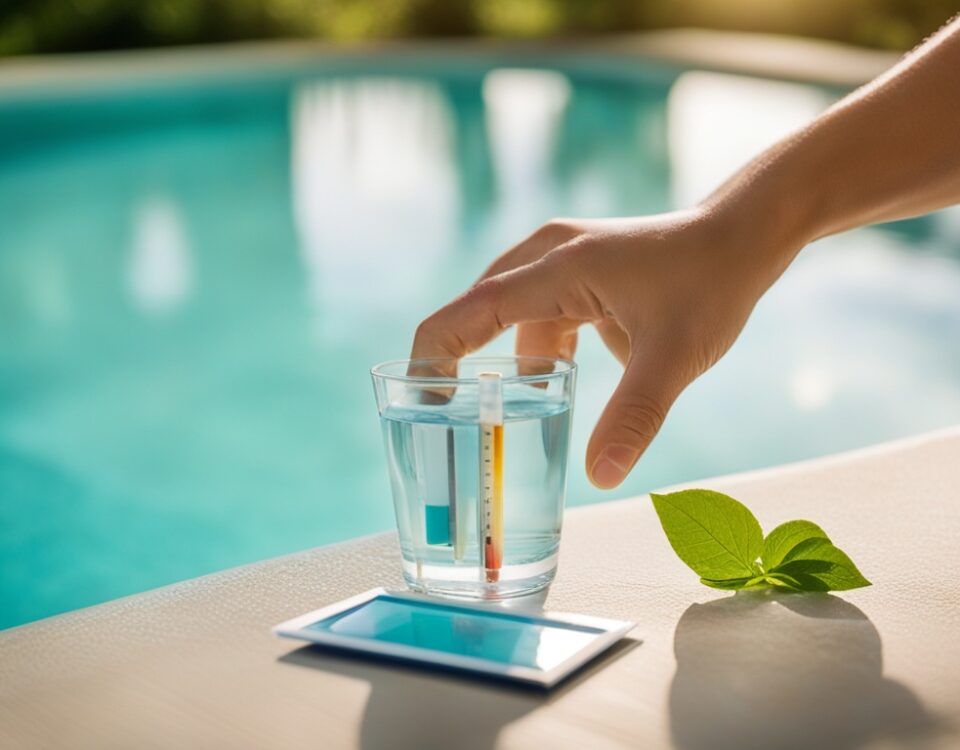Master the Art of Pool Cleaning: Your Ultimate Guide to Vacuuming Like a Pro!

10 Stunning Pool Landscaping Ideas to Transform Your Backyard Paradise
May 2, 2025
Revolutionize Your Swim Season with Solar Pool Heating Systems!
May 3, 2025Preparing for Pool Vacuuming
Importance of Regular Pool Maintenance
Engaging in regular pool maintenance is *essential* for ensuring the longevity of your swimming oasis. A well-maintained pool not only serves as a *sanctuary for relaxation and recreation*, but it also enhances water quality, safety, and aesthetic appeal. Accumulated debris and dirt can lead to a murky environment, promoting algae growth and other pollutants that could compromise the health of swimmers. Therefore, consistent vacuuming is vital for maintaining *optimal hygiene standards* and guaranteeing the clear, inviting appearance of your pool.
Checking Pool Equipment
Before embarking on the vacuuming process, it is crucial to perform a thorough assessment of your pool equipment. Ensure that your vacuum hose is intact, free of leaks, and properly connected to both the vacuum and the skimmer or filter. Inspecting the filter for clogs will also maximize the efficiency of your cleaning efforts. Additionally, verify that the *pump is operational*, as a malfunctioning pump can diminish water circulation and hinder your vacuuming results. Regular equipment checks aid in pinpointing potential issues before they escalate, allowing for seamless swimming experiences.
Choosing the Right Vacuum for Your Pool
Selecting an appropriate vacuum for your pool type is an integral aspect of effective vacuuming. Pools can be classified into various categories: *in-ground*, *above-ground*, and *infinity pools*, each necessitating different vacuuming solutions. While suction-side vacuums are excellent for *in-ground pools* due to their efficient debris collection, robotic vacuums offer an effortless solution suited for *above-ground pools*, as they often require minimal human intervention. Consider the size of your pool, the types of debris you’ll encounter, and budget constraints when making your selection.
| Type of Pool | Recommended Vacuum Type | Features |
|---|---|---|
| In-Ground Pools | Suction-Side Vacuum | *Efficient debris collection, works with pool pump* |
| Above-Ground Pools | Robotic Vacuum | *Automated cleaning, lightweight and easy to store* |
| Infinity Pools | Pressure-Side Vacuum | *Gentle on surfaces, ideal for delicate finishes* |
Taking the time to evaluate your specific vacuuming needs not only enhances cleaning efficiency but plays a pivotal role in ensuring the *health and safety* of all pool users. Investing in the right vacuum equipment is an essential step that underscores your commitment to quality pool care. By adhering to these preparatory guidelines, you’ll set the stage for a seamless and productive vacuuming experience.
Setting Up Your Pool Vacuum
Attaching the Vacuum Head to the Telescopic Pole
To initiate the process of vacuuming your pool efficiently, it is essential to first attach the vacuum head to the telescopic pole. Begin by ensuring that both components are clean and free from debris. Align the vacuum head at the end of the telescopic pole and secure it using the locking mechanism that typically features a lever or a screw, depending on the model you possess. A firm attachment is crucial, as it prevents any disconnection while you maneuver through the *depths of your pool*, enabling a thorough cleaning process.
Connecting the Hose and Vacuum Head to the Filtration System
Once the vacuum head is securely fastened, the next step involves connecting the hose. Insert one end of the hose firmly into the vacuum head; ensure it is tightly placed to avoid any air leaks that might impair suction. Extend the hose to your pool’s filtration system, ensuring there are no kinks or obstructions that could disrupt the flow. Attach the other end of the hose either to the skimmer or a designated vacuum port, as per your setup. *Double-check* that everything is connected properly; a well-sealed hose guarantees effective suction, ensuring that dirt and debris are efficiently removed from the pool floor.
Checking the Water Level in the Pool
Before proceeding with the vacuuming process, it is imperative to check the water level in your pool. The water should ideally be at least halfway up the skimmer for optimal suction performance. If the water level is too low, it could lead to a malfunction in your filtration system and impair the vacuuming process. In the event that the water exceeds the recommended level, you may need to use a submersible pump to *reduce* the water level to the appropriate height, ensuring a seamless cleaning operation.
Ensuring Proper Equipment Functionality
It’s prudent to perform a quick check-up on your filtration system and vacuuming equipment before you get started. Ensure that the pump is functioning properly by observing a steady flow of water. If you notice any unusual sounds or vibrations, these could be indicators of an *underlying issue* that may impede the cleaning process. Regular maintenance of your pool equipment not only prolongs its life but also enhances cleaning efficiency.
Preparing Your Vacuuming Technique
Understanding the correct technique is essential for effective pool vacuuming. Start at the deep end of your pool and work towards the shallow end, systematically overlapping your paths for thorough coverage. By maintaining an even and slow pace, you allow the vacuum head to capture *even the tiniest debris*, resulting in a sparkling clean surface. It is often advisable to move the vacuum head in a *zigzag pattern* to ensure no area is overlooked.
Utilizing Additional Tools
In addition to your primary vacuum setup, consider utilizing complementary tools such as surface skimmers and brushes. While the vacuum head does the heavy lifting for debris at the bottom, these additional tools can address *surface-level algae* and leaves, enhancing your overall pool maintenance routine. By incorporating a comprehensive cleaning strategy, you not only improve the aesthetics of your pool but also ensure a *cleaner, healthier swimming environment*.
Vacuuming the Pool
Starting at the Shallow End
To achieve optimal results when vacuuming your pool, it is essential to *begin at the shallow end*. This method not only prevents debris from being pushed into previously cleaned areas but also conforms to the natural flow of dirt and debris accumulation, which tends to settle at the pool’s lowest points. By starting at the shallow end, you ensure that the vacuum has a clear path to suck up particles effectively, creating a tidy and pristine swimming environment.
Using Slow and Even Movements
A common mistake when vacuuming a pool is to rush through the process. To ensure a thorough clean, it is imperative to employ *slow and even movements* while navigating the vacuum across the pool floor. This technique allows the vacuum to have adequate time to catch all lingering debris, leaves, and dirt particles. Rushing can result in missed spots, requiring you to revisit areas and prolonging your cleaning session. Aim to maintain a steady pace, covering each section methodically.
Overlapping Vacuuming Areas
Adaptability is key when vacuuming your pool. Be sure to overlap your vacuuming paths to prevent any overlap gaps, which can lead to unsightly debris being left behind. By taking this approach, you can guarantee that every inch of the pool’s surface is covered, enhancing the thoroughness of your cleaning efforts. *Overlap your vacuuming areas* by approximately 10-15% with each pass, ensuring that no debris remains unaddressed. This meticulous attention to detail will ultimately result in a shimmering clean pool.
Paying Attention to Difficult Spots and Corners
Pools invariably possess areas that tend to collect more dirt, such as corners, steps, and other hard-to-reach spots. It is crucial to pay *special attention* to these *difficult spots and corners* during your vacuuming routine. Utilize the appropriate attachment for your vacuum to focus on these areas, ensuring that you suction up any lingering debris that could compromise the pool’s aesthetic and hygiene. Additionally, prolong your vacuuming in these locations, allowing enough time for the suction to work effectively and remove stubborn dirt and buildup.
Cleaning the Vacuum Equipment
Maintaining *optimal vacuum performance* requires diligent care of the vacuum equipment. Regular cleaning not only enhances its efficiency but also extends the lifespan of your tools. Below are crucial steps involved in cleaning your vacuum equipment.
Emptying the Skimmer Basket
The skimmer basket is an essential component in your pool’s filtration system, as it captures debris and prevents clogging in the filter. To begin the cleaning process, start by turning off the pool pump to ensure safety. Remove the skimmer lid, carefully lifting out the basket, and dispose of the accumulated debris. Rinse the basket with a hose to eliminate any remaining particles, and replace it securely back in the skimmer. Frequent cleaning of the skimmer basket, ideally on a weekly basis, can greatly improve the vacuum’s operational efficiency.
Backwashing the Filter
The *filter* plays a pivotal role by trapping impurities and ensuring clean water circulates through your pool. Over time, debris accumulates in the filter media, leading to decreased performance. To rejuvenate the filter, perform a backwash according to the manufacturer’s guidelines. Typically, this involves turning the valve to the ‘backwash’ position, activating the pump, and allowing it to run until the water in the sight glass runs clear. This process effectively cleans out trapped debris, allowing your vacuum to operate with greater efficacy.
Rinsing the Hose and Vacuum Head
Post-cleaning, it’s vital to maintain the hygiene of your vacuum hose and head. Debris can get lodged in these components, hindering suction power. Begin by detaching the hose from the vacuum head and then running water through the hose to flush out any lingering dirt. *Ensure you rinse both the interior and exterior* of the vacuum head under a spray of water as well. After rinsing, allow these components to dry completely before storing them to prevent mold or mildew buildup, which can adversely affect vacuum function.
| Component | Cleaning Frequency |
|---|---|
| Skimmer Basket | Weekly |
| Filter (Backwash) | Bi-weekly or as needed |
| Vacuum Hose | After each use |
| Vacuum Head | After each use |
By adhering to these meticulous cleaning guidelines, you can ensure your vacuum operates at *peak performance*, providing a consistently pristine swimming environment. Investing time in maintaining your equipment not only optimizes its function but also enhances your overall pool experience.
Tips for Efficient Pool Vacuuming
Vacuuming Frequency Based on Pool Usage
Understanding how frequently to vacuum your pool is essential for maintaining its cleanliness and overall hygiene. Generally, if your pool experiences *heavy usage*, such as frequent gatherings or children’s play, you should consider vacuuming at least once a week. Conversely, during the off-season or if the pool is used sparingly, a bi-weekly vacuuming schedule may suffice. Monitoring the clarity of your water can also guide your vacuuming schedule; if the water appears cloudy or debris is accumulating, it’s time to bring out the vacuum.
Brushing the Pool Walls and Floor Before Vacuuming
Before embarking on the vacuuming process, it is highly advisable to brush the pool walls and floor. This initial step is crucial in dislodging dirt, algae, and debris that may have adhered to the surfaces. Use a nylon or brush attachment suitable for your pool’s surface type—tile, vinyl, or fiberglass to avoid causing damage. By thoroughly brushing the pool, you will aid the vacuum in effectively collecting contaminants that have settled in crevices or been trapped in corners, thus enhancing the overall efficiency of the vacuuming process.
Monitoring the Filtration System Pressure
A well-functioning filtration system is paramount in maintaining the cleanliness of your pool. It is *imperative* to monitor the filtration system’s pressure gauge regularly, as increased pressure often indicates that the filter is becoming clogged or that the vacuuming process is becoming less efficient. If you observe a pressure spike, consider backwashing or cleaning the filter before vacuuming. Staying on top of filtration pressure not only maximizes the effectiveness of the vacuum but also prolongs the life of your filtration equipment, ensuring peak performance with every use.
Utilizing the Right Equipment
Selecting the appropriate vacuuming equipment is fundamental to achieving optimal results. There is a variety of options available in the market, including manual vacuums, automatic pool cleaners, and robotic vacuums. Each type offers unique advantages, depending on your pool’s size and shape. Investing in a *high-quality vacuum* can significantly reduce your cleaning time and increase the efficacy of your maintenance routine. Be sure to align your choice with *your specific pool needs* to maximize efficiency.
Clearing the Pool Surface First
Prior to vacuuming, ensure that the surface of the pool is clear of floating debris like leaves and twigs. Utilizing a skimmer net or leaf rake can significantly aid in this process. Addressing surface debris first prevents it from sinking and complicating the vacuuming procedure, allowing you to focus on the bottom and sides of the pool. This preparatory step is integral to achieving a thorough cleaning, as it makes the subsequent vacuuming process smoother and more efficient.
Optimizing Water Level During Vacuuming
Maintaining the appropriate water level during the vacuuming process is essential to ensure that the vacuum can operate efficiently. A water level that is too low can result in the vacuum sucking in air, which diminishes its sucking power and effectiveness. Typically, the water level should be maintained at the *midpoint of the skimmer*. If necessary, add water before starting to vacuum, ensuring that the device captures debris effectively without interruption.
Troubleshooting Common Pool Vacuuming Issues
Dealing with Clogs in the Hose or Vacuum Head
Clogs can significantly hinder the efficiency of your pool vacuum, leading to subpar cleaning results. If you notice a decrease in suction or the vacuum stops working entirely, the first step is to inspect the hose for kinks or debris accumulation. Disconnect the hose and use a garden hose to flush water through it, ensuring that any obstructions are cleared. Regular maintenance is pivotal; always check for leaves, twigs, or dirt caught within the vacuum head, as these can obstruct water flow and decrease suction power.
Addressing Low Suction Power
Low suction power can be indicative of various underlying issues with your pool vacuum system. Begin by examining the filter cartridge or sand filter—if these components are dirty or clogged, they can restrict water flow and lead to inadequate suction. Clean or replace the filter as necessary. Additionally, ensure that the vacuum’s hoses are properly connected and free from leaks. Any air leaks in the hose or connections can also compromise suction; consider using hose clamps to secure the fittings and prevent air ingress.
Fixing Leaks in the Vacuum System
Leaks in your pool vacuum system can manifest in various forms, particularly in the hoses or the vacuum head. To seek out leaks, carefully examine all hoses and junctions for visible signs of wear or damage. A simple method for detecting leaks is to immerse the affected parts in water; look for bubbles forming, which can signify a breach. Once identified, replacement parts can be acquired from local pool supply stores or online retailers. Employing a high-quality pool repair tape can provide a temporary fix until more permanent measures are enacted.
Table of Common Pool Vacuum Issues and Solutions
| Issue | Symptoms | Possible Solutions |
|---|---|---|
| Clogged Hose | Decreased suction, vacuum stops | Flush out hose; inspect vacuum head for debris |
| Low Suction Power | Weak cleaning capability | Clean or replace filters; check for air leaks |
| Leaks in System | Visible water loss; vacuum not operating efficiently | Inspect for damage; replace or repair with tape |
Preventative Measures
To mitigate the chances of encountering common vacuuming issues, it’s essential to take proactive steps. Regularly clean your filters and monitor the condition of your hoses and vacuum components. Establish a routine check-up schedule, ideally before and after the swimming season, to ensure that each part of your system operates smoothly. Additionally, investing in quality equipment and replacement parts can save you from frequent repairs and enhance your overall pool maintenance experience.
When to Call a Professional
While many vacuuming issues can be addressed with basic troubleshooting, some problems might require the expertise of a professional. If you encounter persistent suction problems despite following the above steps or if you suspect a more complex issue within your pool’s filtration system, it may be prudent to consult a certified pool technician. Expert assessments can help identify latent problems that could potentially escalate if left unresolved, ensuring your pool remains in pristine condition for every swim season.
Wrapping Up and Maintaining a Clean Pool
Storing the Vacuum Equipment Properly
Once you’ve successfully vacuumed your pool, the next crucial step is to ensure that your vacuum equipment is stored properly. *Neglecting this practice can lead to wear and tear* on the hoses, brushes, and other components, ultimately diminishing their efficacy. Rinse the vacuum thoroughly to remove any debris, dirt, or chemicals, and allow it to air dry completely before storing it. This will prevent mold and mildew from developing in damp spaces.
Store your vacuum in a cool, dry location, away from direct sunlight, which can degrade the materials over time. Using a dedicated storage container or bag can help maintain organization, making it easier to locate your pool vacuum when it’s time for the next cleaning session. Additionally, consider labeling your storage area to easily differentiate between various cleaning equipment.
Regularly Checking and Cleaning the Pool Filter
Maintaining a clean pool goes beyond just vacuuming; it also requires *regular attention to your pool filter*. Over time, filters can become clogged with debris, leading to reduced filtration efficiency and water quality issues. It’s advisable to check your pool filter at least once a month, or more frequently during peak swimming season.
To clean a reusable filter, follow the manufacturer’s instructions, which may involve rinsing with a hose, soaking in a cleaning solution, or replacing filter cartridges when necessary. For those with sand filters, backwashing may be required to restore proper flow rates. A well-maintained filter system can significantly contribute to *clear, inviting water* and prolong the lifespan of your pool equipment.
Enjoying a Sparkling Clean Pool All Season Long
With your vacuum equipment properly stored and your pool filter diligently maintained, you can revel in the luxury of a sparkling clean pool all season long. Implementing a consistent cleaning schedule that includes weekly vacuuming, regular filter checks, and chemical balancing will ensure that your pool remains a serene oasis.
In addition to routine maintenance, investing in a quality pool cover can further reduce debris accumulation and minimize the frequency of vacuuming needed when the pool is not in use. This not only enhances the cleanliness of your pool but also extends its life and conserves energy used in heating and filtration.
Ultimately, a few proactive maintenance habits will help you enjoy *crystal-clear waters*, making your swimming experience not only enjoyable but also healthier for family and friends. Embrace these practices, and you will undoubtedly appreciate the aesthetic and recreational benefits of your well-kept pool throughout the entire swimming season.
Learn more about Swimming Pool

Javier Morales is passionate about pool design, maintenance, and outdoor living. With years of hands-on experience, he offers practical tips, creative ideas, and expert insights to help readers make the most of their pool spaces. At Piscina Planet, Javier shares everything from seasonal care guides to the latest trends in pool innovation.




